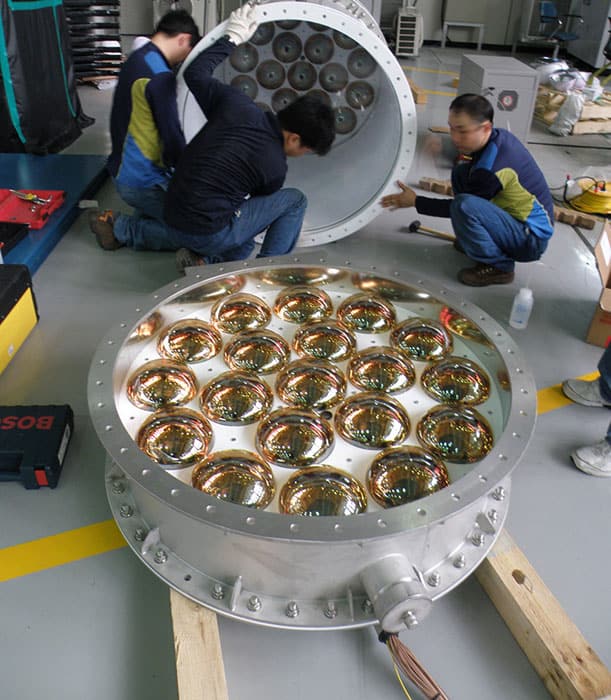Flash Physics is our daily pick of the latest need-to-know developments from the global physics community selected by Physics World‘s team of editors and reporters
Molecular machines put into reverse by light

A material that expands and contracts in response to light has been made using two molecular machines. One component is a Feringa molecular motor first developed by chemistry Nobel laureate Bernard Feringa and colleagues at the University of Groningen in the Netherlands. This motor rotates in one direction when exposed to ultraviolet light (UV). When connected to a network of polymers, the motors twist the polymer strands into braids. This causes the network to contract, thereby doing useable work. However, using these motors to create complex nanomachines is a challenge because the direction of the motor cannot be reversed. Now, Nicolas Giuseppone and colleagues at the University of Strasbourg in France have overcome this problem using a second molecular machine called a modulator that allows the braided polymers to unwind, causing the material to expand. The modulator only allows the strands to unwind when exposed to visible light, so the material can be contracted by exposing it to UV light and then expanded by switching to visible light. The team was also able to control the speed of the expansion and contraction by illuminating the material with combinations of UV and visible light. Giuseppone’s team is now trying to build devices powered by the molecular machines, which they describe in Nature Nanotechnology.
Sterile neutrino search comes up cold

A search for sterile neutrinos by the NEOS experiment in Korea has found no evidence for the hypothetical particles. Predicted by certain extensions of the Standard Model, sterile neutrinos – if they exist – transform into and out of standard neutrinos, revealing themselves via a greater- or lesser-than-expected rate of oscillation between the different types, or “flavours”, of neutrinos. Some past neutrino experiments have hinted that such discrepancies exist and therefore physicists are very keen on finding further evidence for sterile neutrinos – which are expected to interact extremely weakly, if at all, with ordinary matter. The NEOS detector is located just 24 m from the core of a nuclear power plant, which produces vast numbers of antineutrinos. By making a very careful measurement of the energy spectrum of the antineutrinos, physicists working on NEOS concluded that there is no evidence that oscillations involving sterile neutrinos were occurring. On a positive note, the team measured more antineutrinos with energies of about 5 MeV than predicted by theory. This excess, dubbed the “reactor antineutrino anomaly”, has also been seen by other experiments. The measurement is described on arXiv and will be published in Physical Review Letters.
NASA funds four teams to join space-exploration institute
NASA will fund four research teams across the US as part of the Solar System Exploration Research Virtual Institute (SSERVI). NASA created SSERVI to bring together US researchers and help them work with international teams. The virtual platform allows scientists to collaborate and solve questions that are fundamental to advancing research in lunar and planetary science, and human exploration of the solar system. Joining the existing nine members are the Network for Exploration and Space Science (NESS) at the University of Colorado Boulder, the Toolbox for Research and Exploration (TREX) at the Planetary Science Institute in Arizona, the Radiation Effects on Volatiles and Exploration of Asteroids and Lunar Surfaces (REVEALS) at the Georgia Institute of Technology, and the Exploration Science Pathfinder Research for Enhancing Solar System Observations (ESPRESSO) at the Southwest Research Institute in Colorado. Selected from among 22 proposals, the four teams will receive a combined total of $3–5m per year for the next five years. Each group will focus on a different topic. For example, TREX – which will receive $5.5m over the five years and is led by Amanda Hendrix – aims to develop tools and methods for exploration of airless bodies that are coated in fine-grain dust such as the Moon, Martian moons Phobos and Deimos and near-Earth asteroids. “TREX emphasizes fine grains because impact processing [at airless bodies] can produce extremely fine size particles – dust – that have critical effects, both operationally and scientifically, threatening surface operations and confounding and complicating interpretation of conventional remote sensing spectral data,” says team member Faith Vilas. The new teams join others from across the US including groups from John Hopkins University, Brown University and the University of Central Florida.
- You can find all our daily Flash Physics posts in the website’s news section, as well as on Twitter and Facebook using #FlashPhysics.



